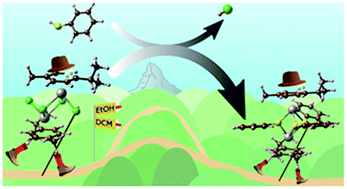Dinuclear thiolato-bridged arene ruthenium complexes: from reaction conditions and mechanism to synthesis of new complexes†
Abstract
Several dinuclear thiophenolato-bridged arene ruthenium complexes [(η6-p-MeC6H4Pri)2Ru2(μ2-SC6H4-R)3]+ (R = H, NO2, F) could so far only be obtained in fair yields using the synthetic route established in the early 2000s. With much less reactive aliphatic thiols or with bulky thiols, the reactions become even less efficient and the desired complexes are obtained with low yields or not at all. We employed density functional theory (DFT) calculations to gain a fundamental understanding of the reaction mechanisms leading to the formation of dithiolato and trithiolato complexes starting from the dichloro(p-cymene)ruthenium(II) dimer [(η6-p-MeC6H4Pri)Ru(μ2-Cl)Cl]2. The results of the DFT study enabled us to rationalise the experimental results and allowed us, via a modified synthetic route, to synthesise previously unreported and hitherto considered as unrealistic complexes. Our study opens up possibilities for the synthesis of so far inaccessible thiolato-bridged dinuclear arene ruthenium(II) complexes but more generally, also the synthesis of other thiolato-bridged dinuclear group 8 and 9 metal complexes could be reexamined.



 Please wait while we load your content...
Please wait while we load your content...